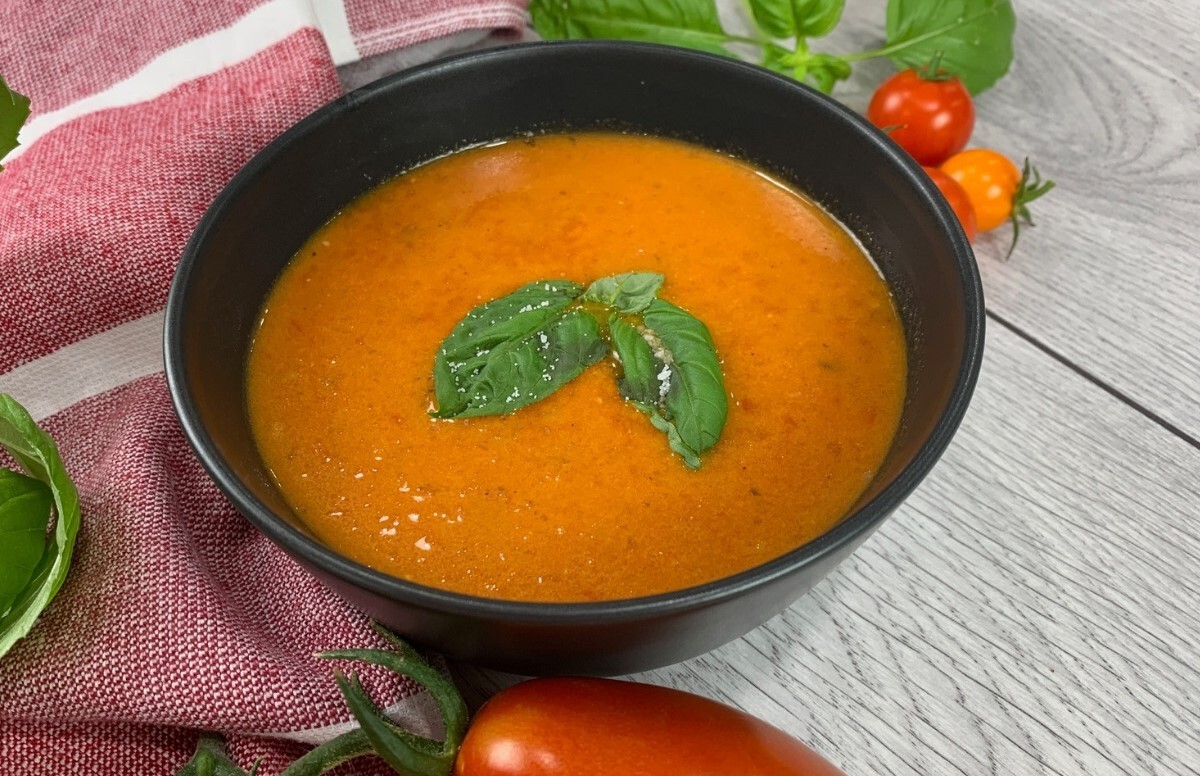Indulge in the comforting flavors of a homemade garden fresh tomato soup. This recipe captures the essence of ripe, juicy tomatoes straight from the garden, combined with aromatic herbs and spices to create a heartwarming dish. Perfect for a cozy meal, this soup is both simple to make and incredibly satisfying.
While most of the ingredients in this recipe are common pantry staples, fresh basil leaves might not be something you have on hand. Make sure to pick up a bunch of fresh basil at the supermarket, as it adds a vibrant and aromatic touch to the soup. Additionally, ensure you have fresh tomatoes, preferably from a garden or farmer's market, to achieve the best flavor.

Ingredients for Garden Fresh Tomato Soup Recipe
Tomatoes: Fresh, ripe tomatoes are the star of this soup, providing a rich and tangy base.
Onion: Adds a subtle sweetness and depth of flavor to the soup.
Garlic: Provides a robust and aromatic quality that enhances the overall taste.
Vegetable broth: Serves as the liquid base, adding a savory element to the soup.
Olive oil: Used for sautéing the onions and garlic, adding a hint of richness.
Salt: Enhances the natural flavors of the ingredients.
Black pepper: Adds a touch of heat and complexity.
Sugar: Optional, but can balance the acidity of the tomatoes if needed.
Basil leaves: Fresh basil adds a fragrant and herbaceous note to the soup.
Technique Tip for This Recipe
When sautéing the onions and garlic, make sure to cook them until they are translucent and fragrant, but not browned. This will ensure that the flavors are well-developed without adding any bitterness to the soup. Additionally, when pureeing the soup, you can use an immersion blender directly in the pot for a smoother texture and easier cleanup. If you prefer a chunkier consistency, blend only a portion of the soup and mix it back in.
Suggested Side Dishes
Alternative Ingredients
fresh from the garden tomatoes - Substitute with canned tomatoes: Canned tomatoes can be used when fresh tomatoes are not available. They are picked and canned at peak ripeness, ensuring good flavor.
onion - Substitute with shallots: Shallots have a milder and sweeter taste compared to onions, making them a good alternative in soups.
garlic - Substitute with garlic powder: Garlic powder can be used if fresh garlic is not available. Use about ⅛ teaspoon of garlic powder per clove of garlic.
vegetable broth - Substitute with chicken broth: Chicken broth can provide a similar depth of flavor, though it will no longer be vegetarian.
olive oil - Substitute with canola oil: Canola oil has a neutral flavor and similar cooking properties, making it a suitable replacement.
salt - Substitute with soy sauce: Soy sauce can add a salty and umami flavor, but use it sparingly to avoid overpowering the soup.
freshly ground black pepper - Substitute with white pepper: White pepper has a slightly different flavor but can still provide the necessary heat and spice.
sugar - Substitute with honey: Honey can add a touch of sweetness and a slight floral note to the soup.
fresh, chopped basil leaves - Substitute with dried basil: Dried basil can be used in place of fresh basil, though it is less potent. Use about one-third of the amount of fresh basil called for.
Other Alternative Recipes Similar to This Soup
How To Store / Freeze Your Tomato Soup
Allow the soup to cool completely before storing. This helps to maintain the integrity of the flavors and prevents condensation from forming inside the storage container.
Transfer the cooled tomato soup into airtight containers or heavy-duty freezer bags. For easy portioning, consider using smaller containers or dividing the soup into individual servings.
Label each container with the date and contents. This is especially helpful if you have multiple soups or stews stored in your freezer.
Store the containers in the refrigerator if you plan to consume the soup within 3-4 days. For longer storage, place the containers in the freezer, where the soup can be kept for up to 3 months.
When ready to enjoy, thaw the frozen soup in the refrigerator overnight. This gradual thawing process helps to preserve the texture and flavor of the soup.
Reheat the soup on the stovetop over medium heat, stirring occasionally until heated through. If the soup appears too thick after reheating, you can add a splash of vegetable broth or water to achieve the desired consistency.
For a quick thawing method, you can place the frozen container in a bowl of warm water for about 30 minutes before transferring it to a pot to reheat.
Avoid reheating the soup multiple times, as this can degrade the quality and flavor. Instead, reheat only the amount you plan to consume.
If you notice any changes in the color, texture, or smell of the soup after storing, it’s best to discard it to ensure food safety.
To elevate the reheated garden fresh tomato soup, consider adding a fresh garnish of chopped basil or a drizzle of olive oil just before serving.
How To Reheat Leftovers
For stovetop reheating:
- Pour the leftover soup into a saucepan.
- Heat over medium-low heat, stirring occasionally to prevent sticking.
- Once the soup is steaming hot and reaches your desired temperature, it's ready to serve.
For microwave reheating:
- Transfer the leftover soup into a microwave-safe bowl.
- Cover the bowl with a microwave-safe lid or plastic wrap with a small vent.
- Heat on high for 2-3 minutes, stirring halfway through to ensure even heating.
- Check the temperature and heat for an additional 1-2 minutes if necessary.
For oven reheating:
- Preheat your oven to 350°F (175°C).
- Pour the leftover soup into an oven-safe dish.
- Cover the dish with aluminum foil to prevent drying out.
- Heat in the oven for about 20-25 minutes, or until the soup is hot and bubbly.
For slow cooker reheating:
- Transfer the leftover soup into your slow cooker.
- Set the slow cooker to the low setting.
- Heat for 1-2 hours, stirring occasionally, until the soup is thoroughly warmed.
For sous vide reheating:
- Place the leftover soup in a vacuum-sealed bag or a ziplock bag using the water displacement method.
- Set your sous vide machine to 165°F (74°C).
- Submerge the bag in the water bath and heat for about 30-45 minutes, or until the soup is hot throughout.
Best Tools for This Recipe
Large pot: Used to heat the olive oil and cook the onions, garlic, and tomatoes. It also holds the vegetable broth and allows the soup to simmer.
Wooden spoon: Ideal for stirring the onions, garlic, and tomatoes as they cook, and for mixing in the vegetable broth.
Chef's knife: Essential for chopping the tomatoes, onions, and basil leaves.
Cutting board: Provides a safe and stable surface for chopping the vegetables and herbs.
Blender: Used to puree the soup until smooth, creating a creamy texture.
Measuring cups: Necessary for measuring the vegetable broth and chopped tomatoes.
Measuring spoons: Used to measure the olive oil, salt, pepper, and optional sugar.
Ladle: Handy for serving the soup into bowls once it's ready.
Garlic press: Useful for mincing the garlic cloves efficiently.
Soup bowls: For serving the finished tomato soup.
Soup ladle: For serving the soup into bowls without making a mess.
How to Save Time on This Recipe
Pre-chop ingredients: Chop the onions, garlic, and tomatoes in advance and store them in airtight containers.
Use an immersion blender: Instead of transferring the soup to a blender, use an immersion blender directly in the pot to save time and reduce cleanup.
Batch cook: Make a larger batch of tomato soup and freeze portions for quick meals later.
Pre-measure spices: Measure out the salt, pepper, and optional sugar ahead of time to streamline the cooking process.
Quick simmer: If you're short on time, simmer the soup for 10 minutes instead of 20.

Garden Fresh Tomato Soup
Ingredients
Main Ingredients
- 6 cups Tomatoes, chopped fresh from the garden
- 1 cup Onion, chopped
- 2 cloves Garlic, minced
- 2 cups Vegetable Broth
- 1 tablespoon Olive Oil
- 1 teaspoon Salt
- 1 teaspoon Black Pepper freshly ground
- 1 teaspoon Sugar optional, to taste
- 1 cup Basil Leaves fresh, chopped
Instructions
- 1. Heat olive oil in a large pot over medium heat.
- 2. Add chopped onions and garlic, sauté until soft.
- 3. Add chopped tomatoes and cook until they start to break down.
- 4. Pour in vegetable broth, bring to a boil, then reduce heat and simmer for 20 minutes.
- 5. Use a blender to puree the soup until smooth.
- 6. Season with salt, pepper, and sugar to taste. Stir in chopped basil before serving.
Nutritional Value
Keywords
More Amazing Recipes to Try 🙂
- Creamy Corn Casserole Recipe55 Minutes
- Southern Baked Yellow Squash Recipe45 Minutes
- Buttermilk Pie Recipe1 Hours 5 Minutes
- Monkey Bread Recipe55 Minutes
- California Roll Sushi Recipe40 Minutes
- Vegan Pancakes Recipe30 Minutes
- Hawaiian Salad Recipe15 Minutes
- Albondigas Meatball Soup Recipe1 Hours


Leave a Reply